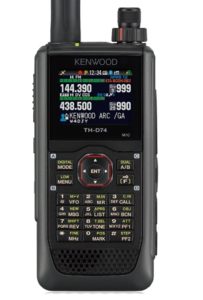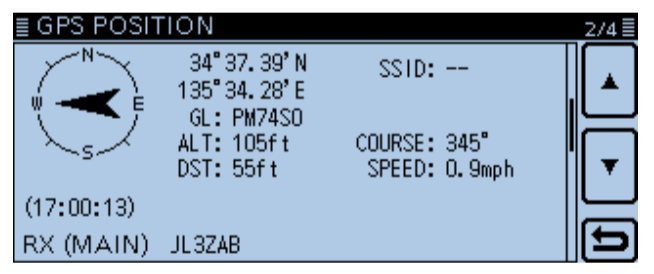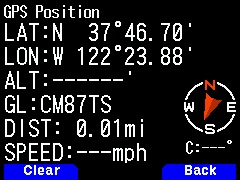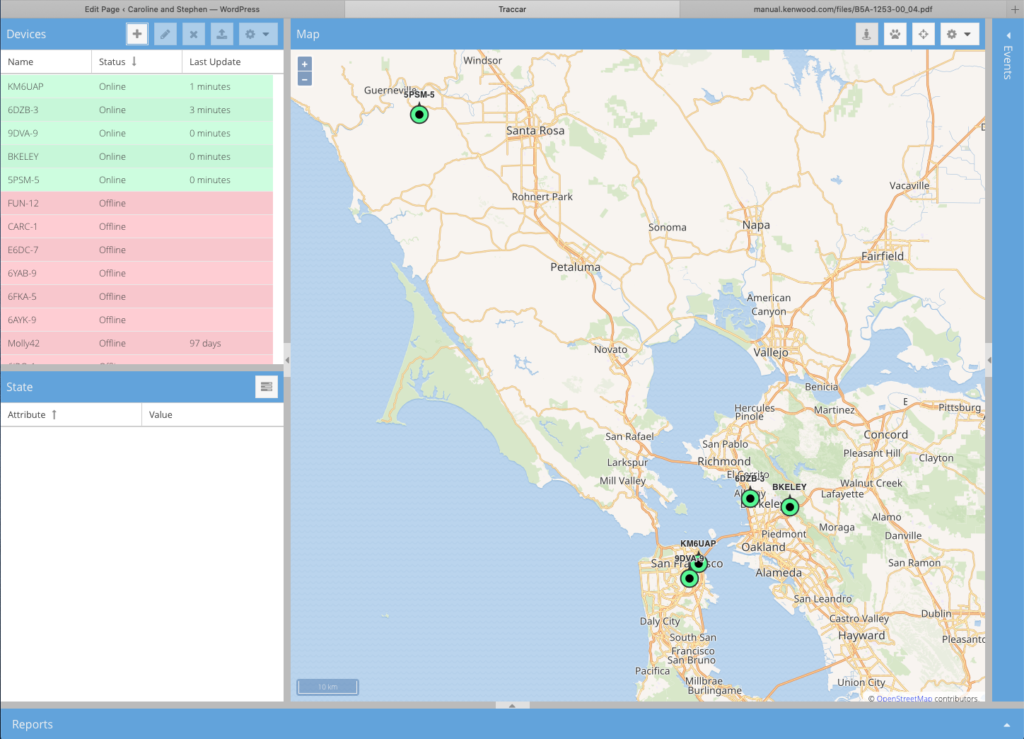Starting with GMRS
Molly has quite the collection of radios. Our everyday radios are based on the GMRS system. They are easy to use, easy to license and certainly get the job done. And GMRS is becoming more and more common in the Overland community.
For us, we mainly use our GMRS radios; 1) to communicate between vehicles that are travelling in convoy, and 2) to stay in touch when out for a walk. The radios work well, but over short distances. Of course, sometimes they don’t work, usually because there is a hill or obstacle that blocks the radio signal.
And while we love our GMRS radios, they can’t not relied upon as an emergency form of communication. For emergencies, we have Garmin inReach devices. We also take these when out on extended walks or they are stored in Molly when we are driving. And we also have HAM or amateur radios, but more on that later.
GMRS Radios
GMRS stands for General Mobile Radio Service. This service is regulated by the FCC (Federal Communications Commission) in the United States. We have 3 GMRS licensed radios, two handhelds which we can carry around and one permanently mounted in Molly. We mainly use the radios for staying in touch when out walking. Even if we both go walking together, we usually take the two handhelds, just in case we later decide to split up.
GMRS radios operate in the UHF (Ultra High Frequency) band, and do not typically perform as well as the HAM radios in outdoor environments, which can operate in the VHF (Very High Frequency) or 2m band.
Our GMRS call-sign is WRTK929
GMRS Handhelds
We have two GMRS Handheld Transceivers, one from Wouxun and one from BTECH. Both of these radios support all of the GMRS channels including the 8 repeater channels. The Wouxun is missing the NOAA Weather Channels and does not support GPS location transmission. It is our older GMRS radio. The newer BTECH radio has NOAA weather and GPS location transmission. All handheld radios are limited to 5 watts of transmission power. The BTECH has an IP67 water/dust resistant rating, so we can take it out in the rain and not worry too much.
GMRS Mobile Transceiver
In Molly, we have a Midland MXT275 mobile radio. The best thing about this radio; it is very easy to use with all of the controls available on the microphone and speaker unit. Like the handheld radios, this radio supports all of the GMRS channels and the 8 repeater channels. It also supports the NOAA Weather Channels. So, it does all we need it to do. It is more powerful than the handheld radios, with up to 50 watts of transmission power. The antenna is mounted high on Molly’s roof rack which also helps with transmission.

Outside of the United States
Unfortunately, GMRS radios certified for use in the United States can’t legally be used outside the United States, and this even includes Canada and Mexico. There are even restrictions when operating these radios close to the Canadian border. Both Canada and Mexico, along with other countries, have their own version of GMRS (or FRS), and these versions are just different enough from the United States version, to make our radios officially illegal. Additionally, our GMRS license is only valid for the United States. Because of all of this, we only use them in the United States.
However, since GMRS is such an effective and cheap radio solution, when we go to Canada and Mexico, we plan to buy extra radios that are legal in those countries. More research is required for countries in South America.
FCC Website – General Mobile Radio Service (GMRS)
History of Our Radio Collection
Our radio collection grew over time. We started with just one handheld HAM radios which we used to listen to automated weather forecasts.
Then we added a HAM mobile transceiver and mounted it permanently in Molly. These two radios allowed us to communicate with each other. This all worked well enough for us. But it turns most of the world does not use HAM or amateur radio. And since the early 2020’s, GMRS has become the more popular radio type in the Overlanding community (at least in the USA).
So, our collection now includes:
- 1x ICOM ID-5100A Deluxe – Digital Dual Band Mobile Transceivers
- 1x Kenwood TH-D74A – Digital Tri-band Handheld Transceiver
- 1x Midland MXT275 – GMRS Mobile Transceiver
- 1x BTECH GMRS-PRO – GMRS Handheld Transceiver
- 1x Wouxun KG-805G Professional – GMRS Handheld Transceiver
The HAM radios are more expensive, have more features and functions, can transmit with higher output power but are more complicated to setup and operate. In the United States you need to pass a written exam before you can get your license to use a HAM radio. In contrast, the GMRS radios are very easy to operate, there is no exam to pass and are becoming the more popular radio system for those in the Overlanding community.
The mobile types are permanently mounted under the passenger seat with a cable running to a fixed antenna on the cab roof. We have only one antenna, which is connected to either the HAM or the GMRS, but not both at the same time. So, depending on the particulars of the trip, we will connect the most appropriate radio. And there are enough distractions in the front cab without having two different radios operating at the same time. The handhelds are intended to be portable, and we carry them with us when we are away form Molly, usually when one of us is out for a walk.
GMRS is now our preferred radio system.
License Class. We have radios with two types licenses; a) HAM and b) GMRS. The HAM radios are licensed to allow more power and over a greater range of frequencies than GMRS. GMRS radios are easier to use, but have a more limited license and can only transmit on 22 frequencies and at quite low power. The electronics inside the radios are designed to align with the license, which is governed and issued by the Federal Communication Commission (FCC).
Portability Class. In the HAM radio world different names are given to radios based on how they are used. Portable self-powered radios that you keep with you are called Handheld Transceivers or HT. Radios designed to be permanently mounted in a vehicle or elsewhere are called Mobile Transceivers or MT. Molly has both handheld and mobile types.
HAM Radios
HAM radios have been around for a long time and the amateur community continues to evolve technology and HAM radio manufactures continue to produce better and better radios. As a consequence, HAM radios are packed full of features. Of course we wanted good short range point-to-point communication, but we also wanted a digital mode for the transmission of location information.
The 2m or VHF band is ideal for short range communication. With a clear line-of-sight, we can typically communicate up-to 5 to 10 kms, and even further if a repeater is available or one of us is on a mountain top. D-Star is a digital mode that supports GPS reception from other D-Star capable radios – more on that in a bit.
Both the ICOM-5100A and Kenwood TH-D74a support the 2m band and the D-Star digital mode including the transmission of GPS coordinates between each other.
Our HAM call-sign is K6MOL.
2m Band Communication
The 2m band is good for short range point-to-point communication, this could be to allow one vehicle to communication to another vehicle while travelling together, or to communicate back to Molly while one of us is out for a walk.
Point-to-Point or Radio-to-Radio communication in the HAM radio world is called Simplex. The main advantage of Simplex is that it does not require a local repeater1, and can therefore work anywhere, you just need two radios.
The disadvantage of Simplex is that communication distance is limited by the curvature of the earth, the height of each antenna above the ground and any obstructions. The antenna on Molly is located on the roof rack over the front cab. The Kenwood handheld radio has a short rubber-ducky antenna. Neither are very large or high antennas.
D-Star Digital Communication
There are many ways for one radio to communicate with another. Analog or FM is very popular, but we decided to base our radio communication on digital, or Digital Voice (DV). Within the HAM radio world there are three different digital systems, we chose the D-Star system. FM analog or either of the other two digital systems would work just as well.
Digital Voice has the advantage that the audio quality is really good. But this is not the main reason we went with a digital system. The main reason is that D-Star can transmit location coordinates from a GPS signal.
Sending and receiving Location Coordinates (GPS)
Overlanding is all about where you go; having a radio that can transmit and receive location coordinates allows us to know where each radio is. This could be a radio in another vehicle or a radio with someone who is out for a walk. The location coordinates can also be sent to the internet to be displayed on live map.
D-Star supports sending location coordinates during normal voice communication. No need to do anything fancy, just talking on the radio will display how far away the other radio is, and therefore how far away the person is. The radios can also be set-up to beacon, which involves sending the location coordinates on a regular schedule, say every 10 minutes. The radios also have another digital feature called APRS, which is yet another digital mode, slightly different than D-Star, that can also beacon location coordinates, as well as exchange messages and even email with other HAM operators. We are probably not going to use the message and email features as we have other and easier ways to do this.
Both of the HAM radios can receive transmissions from the GMRS radios, but are frequency locked and can’t respond or transmit back. And the Wouxun KG-805G handheld can receive some HAM frequencies, but can’t transmit. License restrictors only apply to transmission, so it is legal to listen on frequencies outside what the radio is classified for. So, technically we could mix and match the radios if we wanted as long as we don’t transmit incorrectly.
The HAM Radio Details

The ICOM ID-5100A radio is located in front cab. The base unit is under the passenger side seat, the head unit is in our center console and the microphone is hanging between the front cab and the house in the passthrough. The location of the microphone allows the radio to be used while driving or from the house when stopped. Both the head unit and the microphone are on extension cables, so they can be moved around a little if needed. In our case we used ICOM IC-OPC-440 and ICOM IC-OPC-1156.
The base unit also has the ICOM UT-133 bluetooth adaptor installed. This allows the radio to be controlled from our Garmin Overlander, and means the head unit does not need to be used while driving. To make this work, we side-loaded an android app made by ICOM called RS-MS1A. Unfortunately the bluetooth adaptor can not be used to pair with a speaker. We can add a speaker if we wish, and might do that in the future.
Also connected to the base unit is 12 volt power and an antenna. The antenna is a Tram 1181 (140MHz-170MHz + 430MHz-470MHz Dual Band NMO). We also experimented with a data connection to our computer and although it works, we have not permanently connected it up for the moment. We just connect with a temporary cable when we want to use it, and then disconnect it after we have finished. One day will probably run permanent cabling.
The data connection between the ID-5100A and the computer uses an RT Systems RTS05 cable, which converts the RS-232 transmit (TXD) and receives (RXD) signals into USB. Fortunately the linux computer had the right drivers for this cable. The ID-5100A data port can be used for lots of different things, we have it set up to output location coordinates received from other D-Star radios.
Refer to the Low speed data communication in section 7 of the ID-5100A manual for setup details. In complete irony, the best way to output DPRS GPS signals is by setting “GPS Out” to “OFF: (page 12-20 for details). If you have this set to “ON”, then the GPS location of the ID-5100A will be sent out the data port, and this prevents the DPRS GPS coordinates being sent out.
Although the linux system recognized the RTS05 cable, for some reason it did not default to the correct baud rate. The command sudo stty -F /dev/ttyUSB0 9600 fixed this. Or alternatively node-red can be used to connect to the serial port.
The following is an example of GPS data received on the ID-5100A from the TH-D74a as presented on the data output port
$GPGGA,021143.00,3746.70,N,12223.87,W,1,07,1.2,24.1,M,-28.0,M,,*61
$GPRMC,021143.00,A,3746.70,N,12223.87,W,0.0,0.0,300120,15.1,W,A*0B
KM6UAP , 
The Kenwood TH-D74a is a lot simpler and is used as a handheld. It is charged by a 110 volt charger. This is a nice little radio that is easy to throw into a bag, just in case.
DPRS
Both radios support DPRS which is a protocol to send location information. We configured the TH-D74a radio to send NEMA based GPS sentences (using DPRS) back to the ID-5100A located in Molly. This allows the ID-5100A to display how far away the TH-D74a is, but better still, the ID-5100A can send these same location coordinates to the computer which can log and display the location on our map server.

Unfortunately the same does not work the other way around. Although the TH-D74a (handheld) receives the GPS coordinates from the ID-5100 (base radio), it does not automatically display the location of Molly on the TH-D74a screen during the call. Maybe Kenwood will add this feature one day. It is however possible to look through D-Star RX (receive) log on the TH-D74a and find the position reported during the call. The position can be found by going to menu 600 and then the Position softkey.


D-Star, APRS and Weather
Both the ICOM ID-5100A and Kenwood TH-D74a are D-Star radios, and therefore it can use the D-Star2 network to communicate to any other D-Star radio connected to the D-Star network. Molly just needs to be in radio range of a D-Star Gateway. In New Zealand we have no nearby D-Star Gateways, so we made our own D-Star hot-spot with an OpenSpot2 from RF Shark.
Both the ID-5100A and the TH-D74a can also connect to the APRS-IS3 network using the APRS4 protocol, which essentially allows HAM radios to interface with the Internet. In the USA and Canada, HAM Radio Operators can transmit their location on frequency 144.390MHz using APRS and this is tracked in real-time.

The format of the waypoint can be set in TH-D74a at menu 540. The following is an example of the Kenwood format
$PKWDWPL,070233,A,3752.66,N,12217.83,W,0,327,300120,000016,KM6UAP-9,\\*64
$PKWDWPL, is the sentence identifier
070233, is the UTC time in hhmmss format
A, is a Valid reading. It is always A
3752.66, is the latitude
N, is North, but could be South
12217.83, is longitude
W, is west, but could be East
0, is speed in knots
327, is course in degrees
300120, is the UTC date in dummy format
000016, is altitude in meters
KM6UAP-9, is HAM Operator callsing
\\ is the APRS symbol
*64. is the checksum
- A repeater is a radio station, typically located on a tall building or mountain top that takes low power signals from HAM radios and re-transmits them at a higher power level. The extra height and extra power means the signal can travel much further. ↩︎
- D-Star is short for Digital Smart Technologies for Amateur Radio. ↩︎
- APRS-IS is short for APRS Internet System. ↩︎
- APRS is short fo Automatic Packet Reporting System. It is a system for sending data, including GPS location data. DPRS is a limited implementation on the D-Star network. ↩︎
